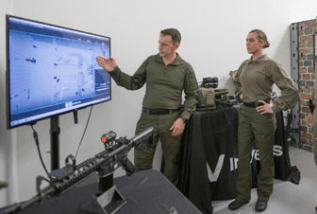Gamification In The Public Sector
Gamification involves individuals at a psychological level, which is far more powerful than normal transactional involvement approaches.
— Brian Burke, Gamify: Just How Gamification Motivates People to Do Remarkable Things
Government training has actually never ever been a lot more vital or much more intricate. From active shooter readiness to cybersecurity readiness, public slaves are progressively phoned call to browse high-stakes circumstances where decisions can have life-or-death repercussions. Typical training approaches like static presentations, dense handbooks, or seldom workshops commonly fall short to involve or prepare individuals for the dynamic challenges they encounter.
Enter gamification: the application of video game layout principles to non-game contexts. In government training, gamification is more than a buzzword; it’s a tested method that boosts engagement, enhances expertise retention, and builds real-world readiness. Whether it’s making use of Enhanced Reality to imitate emergencies, developing severe games for catastrophe feedback, or immersing cyber groups in high-risk assault scenarios, federal government agencies are accepting gamified finding out to change training into a hands-on, high-impact experience.
Allow’s discover exactly how 3 noticeable instances– DHS’s AR-based energetic shooter training, FEMA’s severe games, and the ITU’s Cyber Ranges– demonstrate the power and capacity of gamification in the general public industry.
Examples Of Gamification In Federal government
DHS: Enhanced Reality For Active Shooter Training
With the National Urban Safety Innovation Lab (NUSTL), the United State Division of Homeland Security (DHS) has actually deployed Augmented Fact (AR) systems to support active shooter feedback training. [1] These systems overlay digital risks and items onto real-world atmospheres, transforming an ordinary class or office into a vibrant training ground. Trainees move via physical spaces while replying to online simulation, all offered in genuine time with AR headsets or smart phones.

Image from dhs.gov [1]
Why It Works
AR gamifies the environment itself, giving immersive feedback loopholes that imitate real-life stress factors. Participants must examine threats, choose, and communicate under pressure– much like they would throughout an actual emergency situation. This hands-on, scenario-based training boosts situational awareness and enhances retention much past traditional lecture-based layouts.
The result? Very first -responders leave with muscle memory and confidence that fixed drills seldom offer.
FEMA: Serious Games For Calamity Action
The Federal Emergency Situation Monitoring Agency (FEMA) utilizes serious video games– interactive, scenario-based simulations– to prepare public authorities for natural calamities and complicated emergencies. [2] One instance is FEMA’s Emergency Administration Institute’s Virtual Tabletop Exercises (VTTX), which enable participants to role-play catastrophe circumstances in an electronic setting. Whether collaborating a hurricane evacuation or responding to a chemical spill, gamers choose, assign resources, and adjust to changing conditions.
Why It Works
Serious games enhance systems thinking, enabling individuals to see how their decisions effect others in actual time. They likewise cultivate cross-agency partnership, considering that gamers must work as teams to resolve diverse challenges. With built-in scoring, time constraints, and post-game responses, these simulations develop an engaging discovering experience that mirrors the complexity of real-life situation administration.
FEMA’s use gamification sustains not just readiness but also crucial reflection, enabling leaders to evaluate their methods and improve them before a calamity ever before strikes.
ITU: Cyber Ranges And International Threat Reaction
The International Telecommunication Union (ITU)– a UN firm– uses Cyber Ranges to educate national, regional, and worldwide cyber feedback groups on just how to face digital risks like ransomware, DDoS strikes, and essential facilities hacks. [3] These gamified simulations location individuals in a digital atmosphere where they must protect networks, identify vulnerabilities, and have strikes under time pressure.

Photo from itu.int [3]
Why It Works
Cybersecurity threats develop swiftly, and standard “checklist” training wants. Cyber Varies produce high-fidelity simulations that mimic the complexity of modern cyber warfare. Gamification components– scoring systems, substitute enemies, real-time incident escalations– drive engagement and build the functional skills required for contemporary electronic support.
What makes ITU’s technique specifically powerful is its joint global focus. Groups from different countries can participate in shared simulations, promoting shared standards, quick skill-building, and global cybersecurity strength.
Why Gamification Issues For Federal Government Training
These instances disclose a bigger reality: gamification isn’t just about fun– it’s about function. In high-stakes areas where lives, safety and security, and public count on are on the line, gamification offers:
- Interaction– Interactive circumstances raise student inspiration and minimize cognitive exhaustion.
- Retention– Gamified training turns on numerous finding out methods (aesthetic, acoustic, kinesthetic), improving memory and understanding.
- Comments– Real-time racking up and debriefs provide actionable understandings for students and leaders.
- Versatility– Simulations can be tailored for diverse target markets and transforming hazards.
- Collaboration– Team-based gameplay promotes cross-functional sychronisation and communication.
As innovation progresses and public challenges grow more complicated, gamification remains to play a crucial function in preparing government experts– not just to learn, but to lead in crisis.
From Increased Truth in law enforcement to disaster feedback video games and cyber war simulations, gamification is no more a future trend; it’s a current vital. For agencies seeking to develop durable, prepared, and agile groups, it’s time to elevate the technique with game-based knowing.
References:
[1] Enhanced Truth (AR) Training Equipments for First Responders
[2] Significant video games in FEMA Regional Action
[3] CyberDrills

